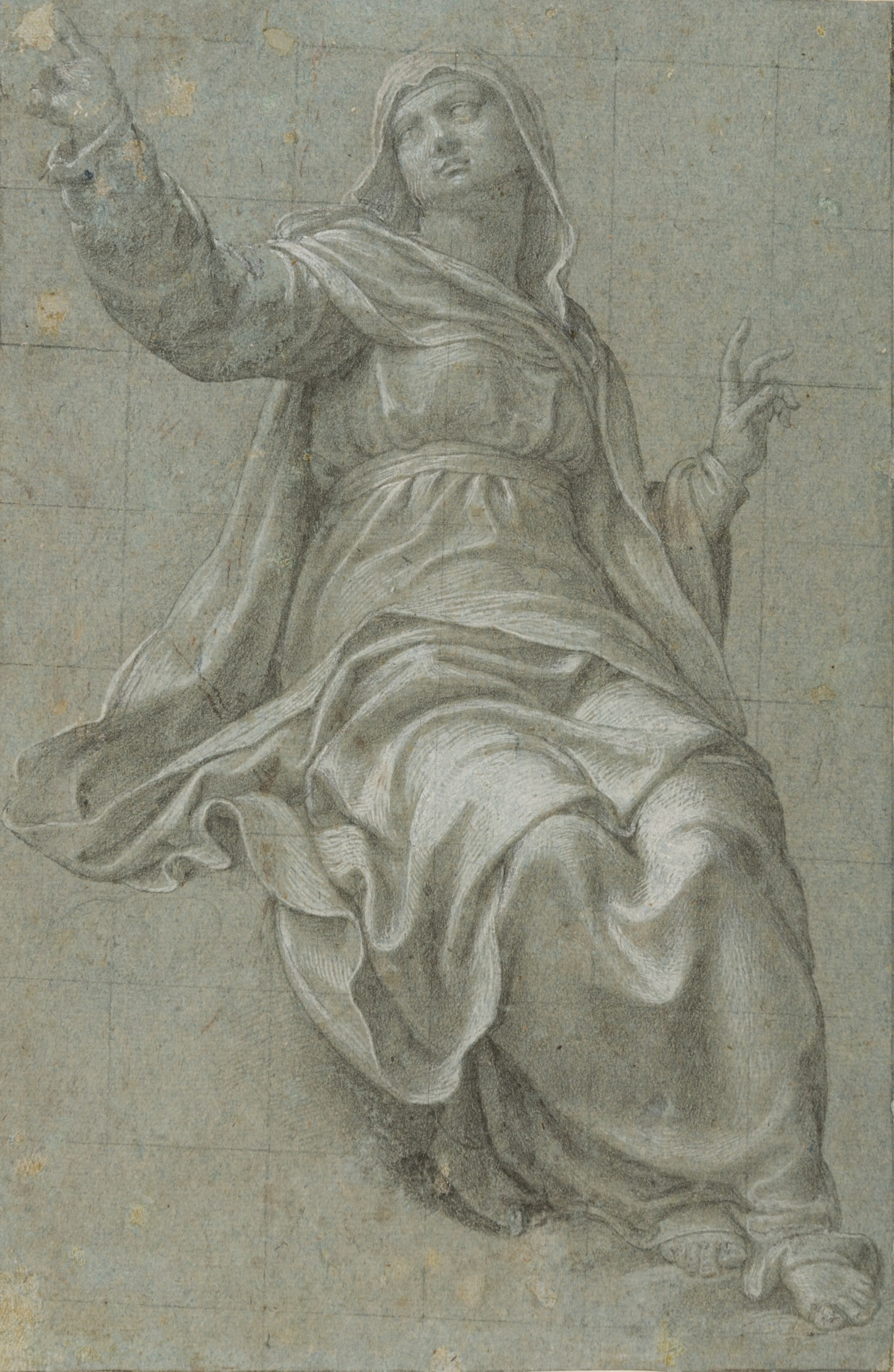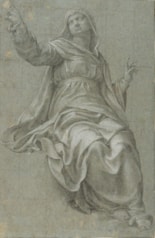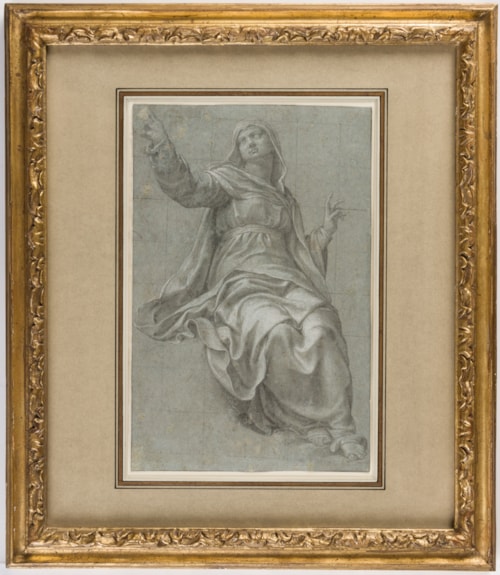Girolamo SICIOLANTE DA SERMONATA
(Sermoneta c.1521 - Rome 1575)
The Seated Virgin
Sold
Black chalk, extensively heightened with white, on blue paper, backed.
Squared for transfer in black chalk, and with framing lines in black chalk.
Inscribed (in a modern hand) Coll B. West. / Sebastiano del / Piombo on the verso.
264 x 172 mm. (10 3/8 x 6 3/4 in.)
Squared for transfer in black chalk, and with framing lines in black chalk.
Inscribed (in a modern hand) Coll B. West. / Sebastiano del / Piombo on the verso.
264 x 172 mm. (10 3/8 x 6 3/4 in.)
This fine drawing is a preparatory study for the figure of the Virgin in the centre of a semi-dome fresco of The Assumption of the Virgin, part of an extensive fresco cycle by Girolamo Siciolante in the Fugger chapel of the Roman church of Santa Maria dell’Anima, the church of the German congregation in Rome. The construction and decoration of the chapel had originally been commissioned by the German merchant and banker Anton Fugger, and at his death in 1560 patronage of the chapel passed to his nephew, Hans Jakob Fugger. It was he who probably commissioned the fresco decoration from Siciolante, sometime around 1560. As Marcia Hall has pointed out, ‘Siciolante was perhaps a logical choice of painter for a northern European patron like Fugger, who may have had little enthusiasm for the elitist sophistication and peculiar calligraphy of the Maniera. He may well have preferred the unadorned, more bourgeois style in which Siciolante rendered the familiar scenes.’
Generally dated to the early 1560s, the frescoes of scenes from the life of the Virgin in the Fugger chapel in Santa Maria dell’Anima are among the artist’s finest surviving works in Rome. As the Siciolante scholar John Hunter has written, ‘These paintings in the Fugger Chapel are certainly Siciolante’s most harmonious works; the grand, powerful figures are wrapped in heavy garments that fall softly, with wide, gently swaying folds. The physical action is limited, the emotions restrained, but the figures are full of grace, inserted with a rhythm into meticulously described settings, as an architect would do before a project. The scenery creates a neutral, grey background against which the bright colours of the clothes - red, gold, blue, green, violet - stand out.’
Nine preparatory figure studies by Siciolante for the Fugger chapel commission are known, more than for any other project undertaken by the artist. These drawings, almost all executed in black chalk on blue paper, include three studies for other figures in the half-dome fresco of The Assumption of the Virgin; a Standing Apostle in the British Museum in London, a Kneeling Apostle in the Albertina in Vienna and a Striding Apostle in a private collection in Paris. Preparatory drawings for other frescoes by Siciolante in the Fugger chapel are today in the Palais des Beaux-Arts in Lille, the Pierpont Morgan Library in New York, the Museo Nazionale in Palermo, the Istituto Centrale per la Grafica in Rome and the Biblioteca Reale in Turin. A compositional study for the fresco of The Presentation in the Temple in the Fugger chapel, in pen and brown ink and brown wash on blue paper, was formerly in the Michel Gaud collection in St. Tropez. Among other stylistically comparable drawings by Siciolante is a study of a standing draped female figure in the Musée des Beaux-Arts in Orléans.
As a recent scholar has written of the figure studies for the Santa Maria dell’Anima frescoes, which appear to have been made from posed models, ‘The drawings for the Fugger chapel seem to reflect Siciolante’s deliberate evolution...There is no similar interest in life drawing in Siciolante’s early work, and his new desire to draw from models must have been a means of devising a more normative figural style…The technique of these drawings was also a new one for Siciolante, and one suspects he adopted it after seeing the drawings of Daniele da Volterra…and others in a finely hatched chalk style. Black and white chalk in blue paper had also come to be more frequently used in Rome in the 1550s…’ John Hunter has commented on the present sheet in particular that ‘The Seated Virgindiffers from the figure in the fresco in minor detail, primarily in the folds of the drapery. Unlike the other figure studies for the Fugger Chapel, this drawing is squared for transfer and is a more finished study.’
The present sheet bears the collector’s mark of the American-born history painter Benjamin West (1738-1820), who succeeded Sir Joshua Reynolds as President of the Royal Academy in London and, like him, was an avid collector of drawings. West’s collection of drawings and prints was largely dispersed in two posthumous sales in London in 1820.
Generally dated to the early 1560s, the frescoes of scenes from the life of the Virgin in the Fugger chapel in Santa Maria dell’Anima are among the artist’s finest surviving works in Rome. As the Siciolante scholar John Hunter has written, ‘These paintings in the Fugger Chapel are certainly Siciolante’s most harmonious works; the grand, powerful figures are wrapped in heavy garments that fall softly, with wide, gently swaying folds. The physical action is limited, the emotions restrained, but the figures are full of grace, inserted with a rhythm into meticulously described settings, as an architect would do before a project. The scenery creates a neutral, grey background against which the bright colours of the clothes - red, gold, blue, green, violet - stand out.’
Nine preparatory figure studies by Siciolante for the Fugger chapel commission are known, more than for any other project undertaken by the artist. These drawings, almost all executed in black chalk on blue paper, include three studies for other figures in the half-dome fresco of The Assumption of the Virgin; a Standing Apostle in the British Museum in London, a Kneeling Apostle in the Albertina in Vienna and a Striding Apostle in a private collection in Paris. Preparatory drawings for other frescoes by Siciolante in the Fugger chapel are today in the Palais des Beaux-Arts in Lille, the Pierpont Morgan Library in New York, the Museo Nazionale in Palermo, the Istituto Centrale per la Grafica in Rome and the Biblioteca Reale in Turin. A compositional study for the fresco of The Presentation in the Temple in the Fugger chapel, in pen and brown ink and brown wash on blue paper, was formerly in the Michel Gaud collection in St. Tropez. Among other stylistically comparable drawings by Siciolante is a study of a standing draped female figure in the Musée des Beaux-Arts in Orléans.
As a recent scholar has written of the figure studies for the Santa Maria dell’Anima frescoes, which appear to have been made from posed models, ‘The drawings for the Fugger chapel seem to reflect Siciolante’s deliberate evolution...There is no similar interest in life drawing in Siciolante’s early work, and his new desire to draw from models must have been a means of devising a more normative figural style…The technique of these drawings was also a new one for Siciolante, and one suspects he adopted it after seeing the drawings of Daniele da Volterra…and others in a finely hatched chalk style. Black and white chalk in blue paper had also come to be more frequently used in Rome in the 1550s…’ John Hunter has commented on the present sheet in particular that ‘The Seated Virgindiffers from the figure in the fresco in minor detail, primarily in the folds of the drapery. Unlike the other figure studies for the Fugger Chapel, this drawing is squared for transfer and is a more finished study.’
The present sheet bears the collector’s mark of the American-born history painter Benjamin West (1738-1820), who succeeded Sir Joshua Reynolds as President of the Royal Academy in London and, like him, was an avid collector of drawings. West’s collection of drawings and prints was largely dispersed in two posthumous sales in London in 1820.
Born in the hill town of Sermoneta, southeast of Rome, Girolamo Siciolante joined the Roman studio of Perino del Vaga around 1541, the same year as his earliest known painting, an altarpiece for a small church near his home town. Siciolante entered the Accademia di San Luca in Rome in 1543, and at around the same time painted his first significant work; a Pietà for the Roman church of Santi Apostoli that is now in the Muzeum Narodowe in Poznan, Poland. By 1544 he was working as an assistant to Perino del Vaga on the fresco decoration of the Castel Sant’Angelo, mainly in the Sala Paolina. However, as Marcia Hall has noted of the artist, ‘his temperament did not dispose him to sympathy with Perino’s ornate style. He seems from the start to have been predisposed to the direct expression of religious feeling.’ After working briefly at the ducal court of Pier Luigi Farnese in Parma, he travelled to Bologna, where in 1548 he painted a Madonna and Child with Saints for the high altar of the church of San Martino Maggiore. A few months after Perino’s death in October 1547, Siciolante returned to Rome to work on some of the master’s unfinished projects, notably a fresco of The Baptism of Clovis in the church of San Luigi dei Francesi, completed by 1549. Of around the same date is the decoration of the Caetani chapel in the church of San Giuseppe in the artist’s native Sermoneta, commissioned by his longtime patrons, the Caetani family, as well as a series of paintings for the chapel of the Chateau de la Bastie d’Urfé in France, ordered by the French ambassador to the papal court, Claude d’Urfé. Relatively little is known of Siciolante’s career during the decade of the 1550s, and no works survive from this period, with the possible exception of a fresco cycle in the Palazzo Spada in Rome, which has been dated to the beginning of the decade. An altarpiece commissioned by Pope Julius II for the Roman church of Sant’Andrea in Via Flaminia, for which the artist received payment in 1553, was severely damaged by the flooding of the Tiber four years later.
Unlike his teacher Perino del Vaga and many of his Roman contemporaries, Siciolante seems to have been uninterested in competing for secular decorative commissions. Nevertheless, his somewhat conservative style as a painter found considerable success in post-Tridentine Rome. The 1560s and 1570s saw the artist at the forefront of artistic activity in the city, working in the Vatican and in churches throughout Rome and its environs, as well as receiving numerous private commissions from noble Roman families and members of the papal court. Among the more significant works of his later career were the decoration of the Fugger chapel in the church of Santa Maria dell’Anima and a fresco of The Donation of Pepin for the Sala Regia of the Vatican, commissioned from the artist in 1565. He also produced important paintings for the Roman churches of Santa Maria Maggiore, San Tomaso ai Cenci, Santa Maria in Aracoeli and Santa Maria sopra Minerva, as well as the Basilica of Saint Peter. Twice elected by his peers to head the Accademia di San Luca, by the time of his death in 1575 Siciolante was one of the most prominent and successful painters in Rome, although he left no school or influenced any significant followers.
While Siciolante enjoyed a fruitful career that lasted some four decades, only a relatively few drawings by the artist, numbering less than thirty sheets, are known today. While his early drawings are strongly influenced by the example of Perino del Vaga’s pen draughtsmanship, his mature figure studies in black chalk, of which the present sheet is a particularly fine example, reflect the abiding influence of Michelangelo’s late work in Rome.
Unlike his teacher Perino del Vaga and many of his Roman contemporaries, Siciolante seems to have been uninterested in competing for secular decorative commissions. Nevertheless, his somewhat conservative style as a painter found considerable success in post-Tridentine Rome. The 1560s and 1570s saw the artist at the forefront of artistic activity in the city, working in the Vatican and in churches throughout Rome and its environs, as well as receiving numerous private commissions from noble Roman families and members of the papal court. Among the more significant works of his later career were the decoration of the Fugger chapel in the church of Santa Maria dell’Anima and a fresco of The Donation of Pepin for the Sala Regia of the Vatican, commissioned from the artist in 1565. He also produced important paintings for the Roman churches of Santa Maria Maggiore, San Tomaso ai Cenci, Santa Maria in Aracoeli and Santa Maria sopra Minerva, as well as the Basilica of Saint Peter. Twice elected by his peers to head the Accademia di San Luca, by the time of his death in 1575 Siciolante was one of the most prominent and successful painters in Rome, although he left no school or influenced any significant followers.
While Siciolante enjoyed a fruitful career that lasted some four decades, only a relatively few drawings by the artist, numbering less than thirty sheets, are known today. While his early drawings are strongly influenced by the example of Perino del Vaga’s pen draughtsmanship, his mature figure studies in black chalk, of which the present sheet is a particularly fine example, reflect the abiding influence of Michelangelo’s late work in Rome.
Provenance
Benjamin West, London (Lugt 419)
Geiger collection, New York (as Fra Bartolommeo)
Private collection, Switzerland.
Geiger collection, New York (as Fra Bartolommeo)
Private collection, Switzerland.
Literature
Bernice F. Davidson, Some Early Works by Girolamo Siciolante da Sermoneta, The Art Bulletin, March 1966, p.64, fig.15; Raffaele Bruno, Girolamo Siciolante: revisioni e verifiche ricostruttive, Critica d’arte, no.136, 1974, p.33; Teresa Pugliatti, Girolamo Siciolante da Sermoneta. Considerazioni e proposte per una ricostruzione del percorso stilistico, in John Hunter, Teresa Pugliatti and Luigi Fiorani, Girolamo Siciolante da Sermoneta (1521-1575): Storia e critica, Rome, 1983, pp.99-100, fig.40; John Hunter, The Drawings and Draughtsmanship of Girolamo Siciolante da Sermoneta, Master Drawings, Spring 1988, p.19, p.37, no.13, pl.12; Veronika Birke and Janine Kertész, Die Italienischen Zeichnungen der Albertina: Generalverzeichnis, Vol.III, Vienna, 1995, p.1685, under Inv. 4873; Vincenzo Abbate, Maestri del Disegno nelle collezioni di Palazzo Abatellis, exhibition catalogue, Palermo, 1995-1996, p.161, under no.37 (entry by Simonetta Prosperi Valenti Rodinò); John Hunter, Girolamo Siciolante pittore da Sermoneta (1521-1575), Rome, 1996, p.159, under no.25, pp.265-266, p.279, no.D-15, fig.58; New York, Sotheby’s, Old Master Drawings, 28 January 1998, p.78, under lot 65.





